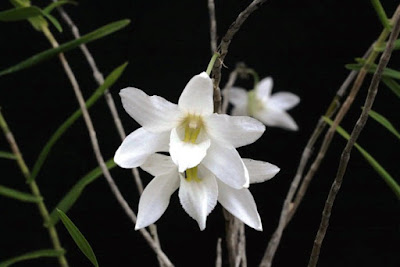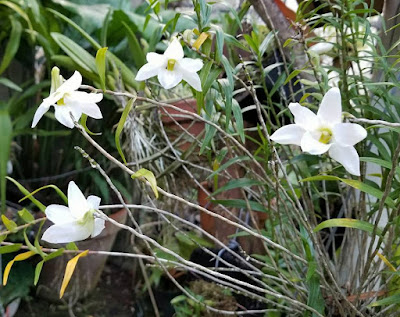Dendrobium auriculatum is native to Philippines. Plants are found in the Bulacan Province on the island of Luzon and in the Davao Province on the island of Mindanao. They usually grow on rocks and trees at an altitude of 900-1000 m.
Dendrobium auriculatum, also called as The Eared Dendrobium, is a species of the genus Dendrobium. This species was described by Ames & Quisumbing in 1932.
IDENTIFY DENDROBIUM AURICULATUM
Dendrobium auriculatum is native to Philippines. Plants are found in the Bulacan Province on the island of Luzon and in the Davao Province on the island of Mindanao. They usually grow on rocks and trees at an altitude of 900-1000 m.
It is a large sized, warm growing epiphyte or lithophyte, which reaching 30-80 cm in height, with a simple, never branching, usually erect, smooth, 30-80 cm long, greenish yellow stem carrying many, linear-lanceolate, acute leaves around the lower portion of the stem.
The Eared Dendrobium blooms in the summer and winter on a terminal, short, single flowered inflorescence with showy flowers arising close on a leafless cane. The impressive flowers are 6 cm in diameter. They are not fragrant. The inner whorls are white, the lip is white with purple at the base. Spur and outer whorl flakes are greenish-white.
DENDROBIUM AURICULATUM CARE AND CULTURE
Cultural information should only be used as a guide, and should be to be adapted to suit you. Your physical location; where you grow your plants, how much time you have to devote to their care, and many other factors, will need to be taken into account. Only then can you decide on the cultural methods that best suit you and your plants.
Light:
Dendrobium auriculatum needs a light level of 18000-24000 lux. Dispersive light is recommended.
Temperature:
It is a thermophilic plant. The average temperature of the day throughout the year is 24-28 ° C, night 15-18 ° C, giving a daily difference of 7-11 ° C.
Humidity:
The Eared Dendrobium needs the humidity of 80-85% in summer and autumn. In winter and spring the humidity drops to 70-75%.
Substrate, growing media and repotting:
Dendrobium auriculatum can be grown in pots in any loose, airy substrate. The substrate should be moist, but not soaked. Repotting is best done in the spring when new roots begin to grow.
Watering:
Water is abundant from late spring to autumn, but is dry for 3-4 winter months. The cultivated plants should be kept moist during the growing season, but in the late autumn the amount of water should be gradually reduced.
Fertilizer:
It is recommended to use a 1/4-1/2 dose of orchid fertilizer weekly. From spring to mid-summer, highly nitrogen fertilizer is recommended, and highly phosphorous from mid-summer to autumn.
Rest period:
During the winter of 3-4 months, reduce the amount of water and allow Dendrobium auriculatum to dry between watering. However, they can not stay dry for too long. Whenever the amount of water supplied decreases, fertilization should also be reduced or eliminated.















I live in the northern US, I bought a small dendrobium auriculatum last fall. It now has no leaves or roots. It seems to still have a crown as some of the stalks are well attached, but no visible roots. Can it be saved? I am soaking it in mild tea for 12 hours and then letting it dry out, and then repeating that a few more times. Do you think that will work?
ReplyDelete